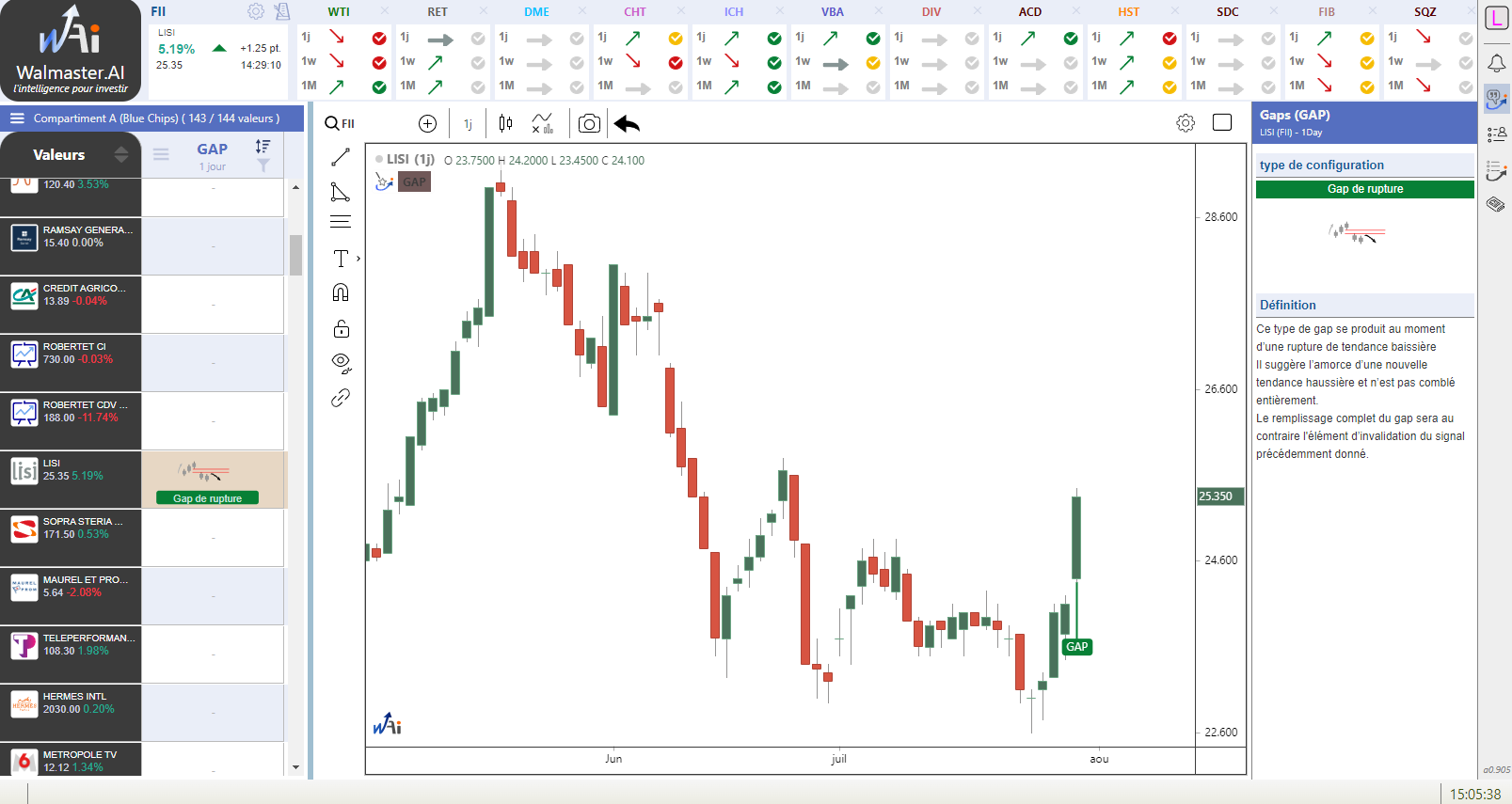Méthode des gaps
Gap Method
Les gaps, sont des espaces vides, qui montrent l'absence de transactions sur certains niveaux de prix et illustrent un décalage entre la demande et l'offre des titres. Cela signifie que durant cet intervalle vide, il n'y a eu aucune transaction entre acheteurs et vendeurs L’une des parties est absente de la transaction dans cet intervalle de prix. En effet il y a plus de vendeurs dans le cas de gap haussier ou plus d’acheteurs dans le cas d’un gap baissier.
Gaps are empty spaces that show the absence of transactions at certain price levels and illustrate a discrepancy between the demand and supply of securities. This means that during this empty interval, there were no transactions between buyers and sellers. One of the parties is absent from the transaction in this price interval. Indeed, there are more sellers in the case of an upward gap or more buyers in the case of a downward gap.
Les gaps peuvent être liés, exclusivement, à des facteurs d'analyse technique:
Gaps can be exclusively related to technical analysis factors:
- le début d’une nouvelle tendance;
- the beginning of a new trend;
- la fin d’une tendance existante;
- the end of an existing trend;
- la force et l’accélération de la tendance en cours.
- the strength and acceleration of the current trend.
Ils peuvent aussi être liés à des facteurs secondaires :
They can also be related to secondary factors:
- les effets d’annonce (le secteur, l’économie);
- announcement effects (sector, economy);
- le manque de liquidité du marché;
- market liquidity shortage;
- le détachement de dividende et autres opérations sur titre;
- dividend detachment and other corporate actions;
- la suspension de cotation.
- suspension of trading.
Vous pourrez voir apparaître des gaps soit lorsque le plus bas d'une période donnée est supérieur au plus haut de la période précédente (gap haussier), soit lorsque le plus haut d’une période donnée est inférieur au plus bas de la période précédente (gap baissier).
You may see gaps appear either when the low of a given period is higher than the high of the previous period (upward gap), or when the high of a given period is lower than the low of the previous period (downward gap).
Les principales fonctionnalités
Key Features
- Détection systèmatique des différents types de gaps (commun, de rupture, de continuation, de fin de mouvement
- Systematic detection of different types of gaps (common, breakaway, continuation, end of movement
- Affichage sur les graphiques de tout les gaps.
- Display of all gaps on charts.

Interprétation des gaps
Gap Interpretation
Le gap commun : Ce gap est le moins significatif. Il apparaît généralement lors d’événements mineurs, mais n'affecte pas la tendance du titre dans la durée. En effet, on peut constater que ce type de gap est la plupart du temps, comblé assez rapidement. On dit qu'un gap est comblé lorsque les cours reviennent sur l'intervalle sans cotation.
Common Gap: This gap is the least significant. It generally appears during minor events but does not affect the stock trend in the long term. Indeed, we can see that this type of gap is most of the time filled quite quickly. A gap is said to be filled when the prices return to the gap interval.
Le gap de rupture (breakaway gap) : Le gap de rupture traduit d'un retournement important dans l’évolution du cours et implique un retournement de tendance. Le gap de rupture apparaît après de nouveaux plus hauts, ou de nouveaux plus bas dans le cas d'une tendance baissière.
Breakaway Gap: The breakaway gap reflects a significant reversal in the price evolution and implies a trend reversal. The breakaway gap appears after new highs, or new lows in the case of a downtrend.
Le gap de continuation (runaway gap) : Le gap de continuation apparaît généralement après un gap de rupture et traduit une accélération du mouvement. Il vient confirmer la force de la nouvelle tendance. Un runaway gap baissier apparaît ainsi dans une tendance baissière et, inversement, un runaway gap haussier apparaît dans une tendance haussière. Il représente un ancien niveau d’entrée où des intervenants avaient ouvert des positions. Le gap de continuation est d’autant plus puissant qu’il est associé à des volumes importants.
Runaway Gap: The runaway gap generally appears after a breakaway gap and reflects an acceleration of the movement. It confirms the strength of the new trend. A downward runaway gap appears in a downtrend, and conversely, an upward runaway gap appears in an uptrend. It represents a former entry level where participants had opened positions. The runaway gap is all the more powerful when associated with significant volumes.
Le gap de fin de mouvement (exhaustion gap) : Le gap de fin de mouvement aussi parfois appeler gap terminal intervient à la fin d'une tendance et indique la proximité du retournement de cette tendance. Il apparaît toujours dans le sens de la tendance en cours et est souvent accompagné par de forts volumes. De ce fait, le gap est rapidement comblé lors du retournement. Pour l'investisseur, ce gap va être l'occasion de clôturer la position en prenant ses bénéfices lorsque le gap de fin de mouvement est comblé.
Exhaustion Gap: The exhaustion gap, sometimes called the terminal gap, occurs at the end of a trend and indicates the proximity of a trend reversal. It always appears in the direction of the current trend and is often accompanied by high volumes. As a result, the gap is quickly filled during the reversal. For the investor, this gap will be an opportunity to close the position by taking profits when the exhaustion gap is filled.